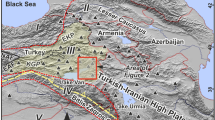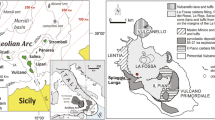Abstract
Complex geochronological and isotope-geochemical studies showed that the Late Quaternary Elbrus volcano (Greater Caucasus) experienced long (approximately 200 ka) discrete evolution, with protracted periods of igneous quiescence (approximately 50 ka) between large-scale eruptions. The volcanic activity of Elbrus is subdivided into three phases: MiddleNeopleistocene (225–170 ka), Late Neopleistocene (110–70 ka), and Late Neopleistocene-Holocene (less than 35 ka).
Petrogeochemical and isotope (Sr-Nd-Pb) signatures of Elbrus lavas point to their mantle-crustal origin. It was shown that hybrid parental magmas of the volcano were formed due to mixing and/or contamination of deep-seated mantle melts by Paleozoic upper crustal material of the Greater Caucasus. Mantle reservoir that participated in the genesis of Elbrus lavas as well as most other Neogene-Quaternary magmatic rocks of Caucasus was represented by the lower mantle “Caucasus” source. Primary melts generated by this source in composition corresponded to K-Na subalkali basalts with the following isotopic characteristics: 87Sr/86Sr = 0.7041 ± 0.0001, ƒNd = +4.1 ± 0.2, 147Sm/144Nd = 0.105–0.114, 206Pb/204Pb = 18.72, 207Pb/204Pb = 15.62, and 208Pb/204Pb = 38.78. The temporal evolution of isotope characteristics for lavas of Elbrus volcano is well described by a Sr-Nd mixing hyperbole between “Caucasus” source and estimated average composition of the Paleozoic upper crust of the Greater Caucasus. It was shown that, with time, the proportions of mantle material in the parental magmas of Elbrus gently increased: from ∼60% at the Middle-Neopleistocene phase of activity to ∼80% at the Late Neopleistocene-Holocene phase, which indicates an increase of the activity of deep-seated source at decreasing input of crustal melts or contamination with time. Unraveled evolution of the volcano with discrete eruption events, lacking signs of cessation of the Late Neopleistocene-Holocene phase, increasing contribution of deep-seated mantle source in the genesis of Elbrus lavas with time as deduced from isotope-geochemical data, as well as numerous geophysical and geological evidence indicate that Elbrus is a potentially active volcano and its eruptions may be resumed. Possible scenarios were proposed for evolution of the volcano, if its eruptive activity were to continue.
Similar content being viewed by others
References
I. V. Chernyshev, V. A. Lebedev, S. N. Bubnov, et al., “Stages of Magmatic Activity in the Elbrus Volcanic Center (Greater Caucasus): Evidence from IsotopeGeochronological Data,” Dokl. Akad. Nauk 380(3), 384–389 (2001) [Dokl. Earth Sci. 380, 848–852 (2001)].
S. N. Bubnov, Extended Abstract of Candidate’s Dissertation in Geology and Mineralogy (IGEM RAN, Moscow, 2003).
V. A. Lebedev, S. N. Bubnov, I. V. Chernyshev, et al., “Basic Magmatism in the Geological History of the Elbrus Neovolcanic Area, Greater Caucasus: Evidence from K-Ar and Sr-Nd Isotope Data,” Dokl. Akad. Nauk 406(1), 78–82 (2006) [Dokl. Earth Sci. 406, 37–40 (2006)].
V. M. Gazeev, Extended Abstract of Candidate’s Dissertation in Geology and Mineralogy (IGEM RAN, Moscow, 2003).
N. V. Koronovskii, “Geological Structure and Evolution of Elbrus Volcano,” in Elbrus Glaciation (Mosk. Gos. Univ., Moscow, 1968) [in Russian].
Geological Map of the Elbrus Volcanic Area on a Scale of 1: 50000 (FGUGP “SevKavGeologiya”, 1996).
G. V. Abikh, “Explanation of Geological Section of the Northern Slope of the Caucasus Range from Elbrus to Beshtau,” in Caucasian Calendar for 1853 (Tiflis, 1852), pp. 440–471.
E. E. Milanovskii and N. V. Koronovskii, Orogenic Volcanism and Tectonics of the Alpine Belt of Eurasia (Nedra, Moscow, 1973) [in Russian].
A. M. Borsuk, Mesozoic and Cenozoic Magmatic Formations of the Greater Caucasus (Nauka, Moscow, 1979) [in Russian].
I. V. Chernyshev, V. A. Lebedev, S. N. Bubnov, et al., “Isotopic Geochronology of Quaternary Volcanic Eruptions in the Greater Caucasus,” Geokhimiya, No. 11, 1–16 (2002) [Geochem. Int. 40, 1042–1055 (2002)].
V. A. Lebedev, I. V. Chernyshev, S. N. Bubnov, et al., “Chronology of Magmatic Activity of the Elbrus Volcano (Greater Caucasus): Evidence from K-Ar Isotope Dating of Lavas,” Dokl. Akad. Nauk 405(3), 389–394 (2005) [Dokl. Earth Sci. 405, 1321–1326 (2005)].
O. A. Bogatikov, I. V. Melekestsev, A. G. Gurbanov, et al., “Radiocarbon Dating of Holocene Eruptions of the Elbrus Volcano in the Northern Caucasus, Russia,” Dokl. Akad. Nauk 363(2), 219–221 (1998) [Dokl. Earth Sci. 363, 1093–1095 (1998)].
O. A. Bogatikov, I. V. Melekestsev, A. G. Gurbanov, et al., “The Elbrus Caldera in the Northern Caucasus,” Dokl. Akad. Nauk 363(4), 515–517 (1998) [Dokl. Earth Sci. 363, 1202–1204 (1998)].
O. A. Bogatikov, I. V. Melekestsev, A. G. Gurbanov, et al., “Catastrophic Pleistocene and Holocene Activity of the Elbrus Volcanic Center (North Caucasus, Russia): Events and Chronology Based on 14C, EPR, and K-Ar Dating,” Vulkanol. Seismol., No. 2, 3–17 (2001).
O. A. Bogatikov, A. G. Gurbanov, D. G. Koshchug, et al., “The EPR Dating of the Rock-Forming Quartz from Volcanic Rocks of the Elbrus Volcano, Northern Caucasus, Russia” Dokl. Akad. Nauk 385(1), 92–96 (2002) [Dokl. Earth Sci. 385, 570–573 (2002)].
O. A. Bogatikov, M. Ch. Zalikhanov, B. S. Karamurzov, et al., Natural Processes on the Territory of Kabardino-Balkaria (IGEM RAN, Moscow, 2004) [in Russian].
M. V. Abdulov, “On Geological Nature of the Elbrus Gravity Anomaly,” Izv. Akad. Nauk SSSR, Ser. Geol., No. 9, 67–74 (1962).
N. V. Koronovskii and L. I. Demina, “Collisional Late Cenozoic Volcanism of the Great Caucasus,” in Proceedings of 3rd All-Russia Symposium on Volcanology and Paleovolcanology. Vol. 1. Volcanism and Geodynamics, Ulan Ude, Russia, 2006 (Buryatsk. Nauchn. Ts. SO RAN, Ulan-Ude, 2006), pp. 219–223 [in Russian].
S. V. Vyatkin, Extended Abstract of Candidate’s Dissertation in Geology and Mineralogy (Mosk. Gos. Univ., Moscow, 2007).
I. V. Chernyshev, V. A. Lebedev, and M. M. Arakelyants, “K-Ar Dating of Quaternary Volcanics: Methodology and Interpretation of Results,” Petrologiya 14(1), 69–89 (2006) [Petrology 14, 62–80 (2006)].
I. V. Chernyshev, A. V. Chugaev, and K. N. Shatagin, “High-Precision Pb Isotope Analysis by Multicollector-ICP-Mass-Spectrometry Using 205Tl/203Tl Normalization: Optimization and Calibration of the Method for the Studies of Pb Isotope Variations,” Geokhimiya, No. 11, 1155–1168 (2007) [Geochem. Int. 45, 1065–1076 (2007)].
R. H. Steiger and E. Jager, “Subcommission on Geochronology: Convention on the Use of Decay Constants in Geoand Cosmochronology,” Earth Planet. Sci. Lett. 36, 359–362 (1977).
V. G. Molyavko, I. M. Ostafiichuk, and N. V. Koronovskii, “Evolution, Chemistry, and Genesis of the Elbrus Volcanics,” Izv. Akad. Nauk SSSR, Ser. Geol., No. 6, 31–46 (1980).
V. M. Gazeev, A. A. Nosova, L. V. Sazonova, et al., “Petrogenetic Interpretation of Phenocryst Association in the Pleistocene-Holocene Volcanics of Elbrus (North Caucasus),” Vulkanol. Seismol., No. 2, 24–45 (2004).
J. A. Pearce, N. B. W. Harris, and A. G. Tindle, “Trace Element Discrimination Diagrams for the Tectonic Interpretation of Granitic Rocks,” J. Petrol. 25, 956–983 (1984).
J. B. Whalen, K. L. Currie, and B. W. Chapell, “A-Type Granites: Geochemical Characteristics, Discrimination and Petrogenesis,” Contrib. Mineral. Petrol. 95, 407–419 (1987).
B. R. Frost, C. G. Barnes, W. J. Collins, et al., “A Geochemical Classification for Granitic Rocks,” J. Petrol 42, 2033–2048 (2001).
V. A. Lebedev, S. N. Bubnov, I. V. Chernyshev, et al., “Geochronology and Genesis of Subalkaline Basaltic Lava Rivers at the Dzhavakheti Highland, Lesser Caucasus: K-Ar and Sr-Nd Isotopic Data,” Geokhimiya, No. 3, 243–258 (2007) [Geochem. Int. 45, 211–225 (2007)].
V. A. Lebedev, I. V. Chernyshev, A. V. Chugaev, et al., “K-Ar Age and Sr-Nd Characteristics of Subalkali Basalts in the Central Georgian Neovolcanic Area (Greater Caucasus),” Dokl. Akad. Nauk 408(4), 517–522 [Dokl. Earth Sci. 408, 657–661 (2006)].
V. A. Lebedev, S. N. Bubnov, I. V. Chernyshev, et al., “Geochronology and Genesis of the Young (Pliocene) Granitoids of the Greater Caucasus: Dzhimara Multiphase Massif of the Kazbek Neovolcanic Area,” Geokhimiya, No. 6, 582–602 (2009) [Geochem. Int. 47, 550–567 (2009)].
B. G. Polyak, I. L. Kamenskii, E. M. Prasolov, et al., “Helium Isotopes in Gases of the Northern Caucasus: Implications for Heat and Mass Influx from the Mantle,” Geokhimiya, No. 4, 383–397 (1998) [Geochem. Int. 36, 329–342 (1998)].
A. W. Hofmann, “Mantle Geochemistry: the Message from Oceanic Volcanism,” Nature 385(16), 219–229 (1997).
Yu. A. Kostitsyn and A. A. Kremenetskii, “Age of Final Magmatic Stage of the Eldjurtu Granite: Rb-Sr Isochron Dating of Apatites,” Geokhimiya, No. 7, 925–931 (1995).
A. Z. Zhuravlev and E. V. Negrei, “Synchronous Formation of the Eldzhurta Granite and Ore-Bearing Metasomatites of Tyrnyauz (North Caucasus) Based on Rb-Sr Data,” Dokl. Akad. Nauk SSSR 332(4), 483–487 (1993).
I. R. Pohl, J. S. Hess, B. Kober, et al., “Origin and Petrogenesis of Miocene Trachyrhyolites (A-types) from the Northern Part of the Greater Caucasus,” in Magmatism of Rifts and Foldbelts (Nauka, Moscow, 1993), pp. 108–125 [in Russian].
S. B. Jakobsen and G. J. Wasserburg, “Sm-Nd Isotopic Evolution of Chondrites and Achondrites,” Earth Planet. Sci. Lett. 67, 137–150 (1984).
A. Zindler and S. Hart, “Chemical Geodynamics,” Annu. Rev. Earth Planet. Sci., No. 14, 493–571 (1986).
P. D. Kempton, R. S. Harmon, C. J. Hawkesworth, et al., “Petrology and Geochemistry of Lower Crustal Granulites from the Geronimo Volcanic Field, Southeastern Arizona,” Geochim. Comochim. Acta 54(12), 3401–3426 (1990).
K. H. Wedepohl, Handbook of Geochemistry. Vol. II/4. 82 (Lead) (Springer-Verlag, Berlin-Heidelberg-New York, 1974).
I. V. Chernyshev, M. M. Arakelyants, V. A. Lebedev, et al., “K-Ar Isotope Systematics and Age of Lavas from the Quaternary Kazbek Volcanic Province, Greater Caucasus,” Dokl. Akad. Nauk 367(6), 810–814 (1999) [Dokl. Earth Sci. 367, 862–866 (1999)].
Author information
Authors and Affiliations
Corresponding author
Additional information
Original Russian Text © V.A. Lebedev, I.V. Chernyshev, A.V. Chugaev, Yu.V. Gol’tsman, E.D. Bairova, 2010, published in Geokhimiya, 2010, Vol. 48, No. 1, pp. 45–73.
Rights and permissions
About this article
Cite this article
Lebedev, V.A., Chernyshev, I.V., Chugaev, A.V. et al. Geochronology of eruptions and parental magma sources of Elbrus volcano, the Greater Caucasus: K-Ar and Sr-Nd-Pb isotope data. Geochem. Int. 48, 41–67 (2010). https://doi.org/10.1134/S0016702910010039
Received:
Published:
Issue Date:
DOI: https://doi.org/10.1134/S0016702910010039




